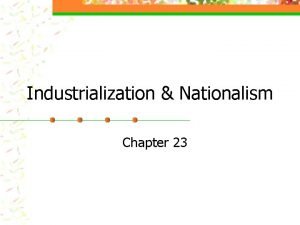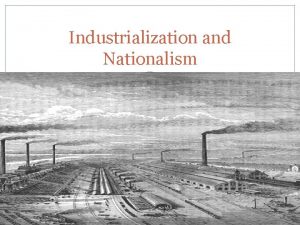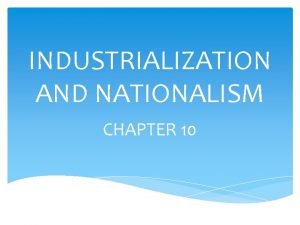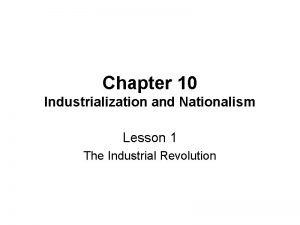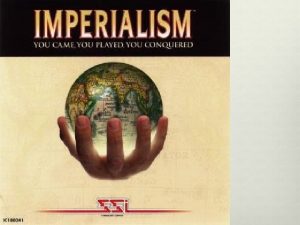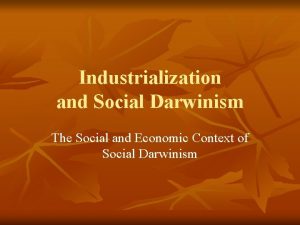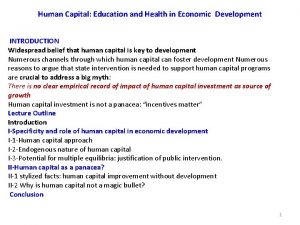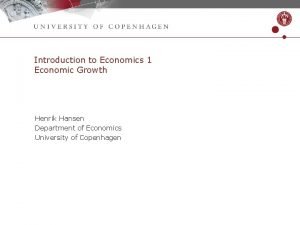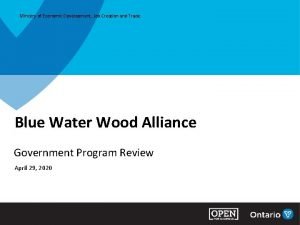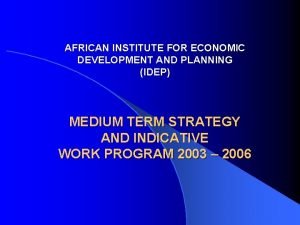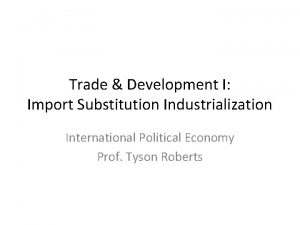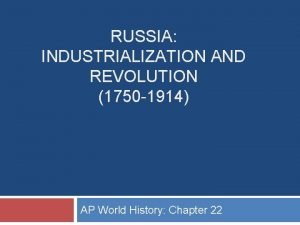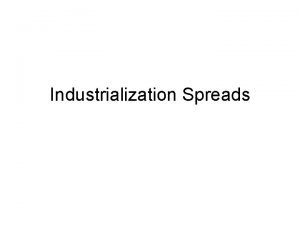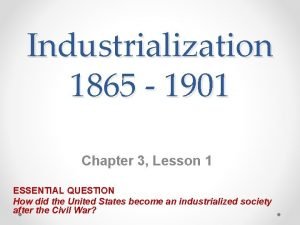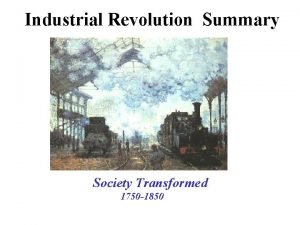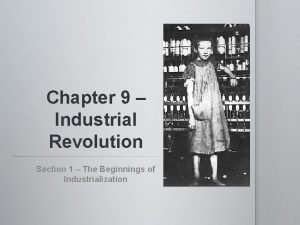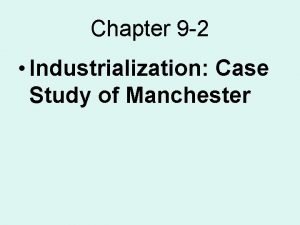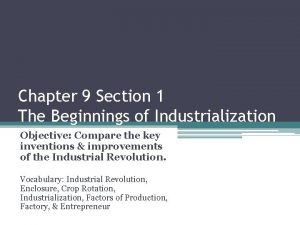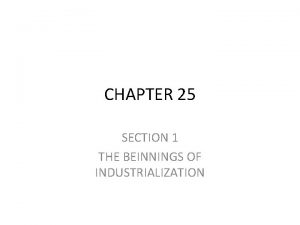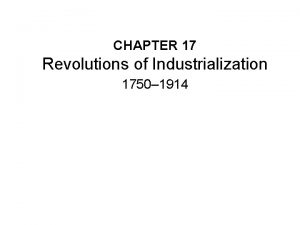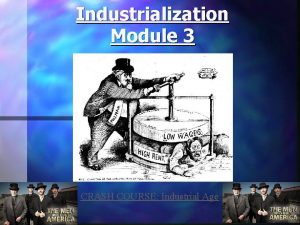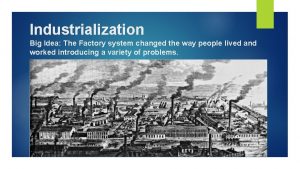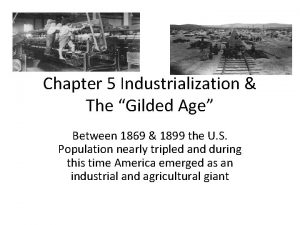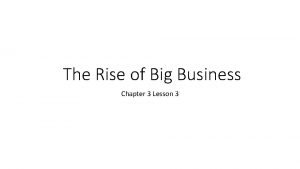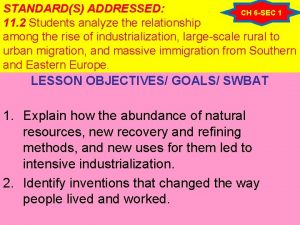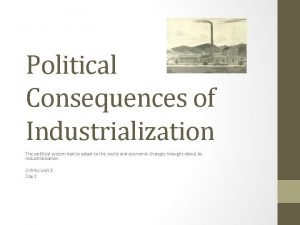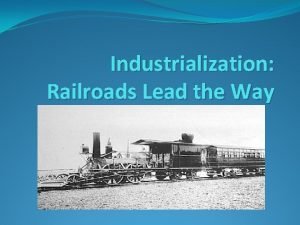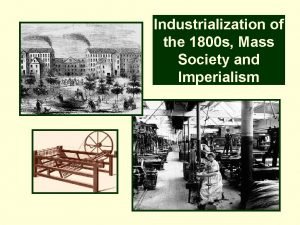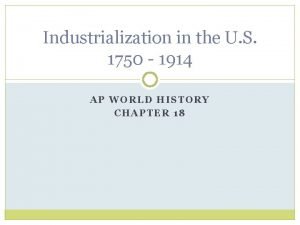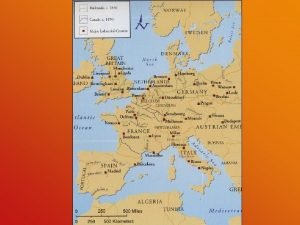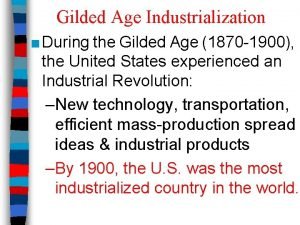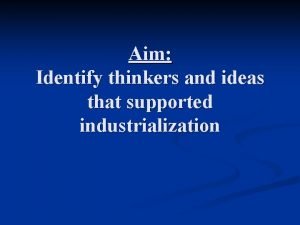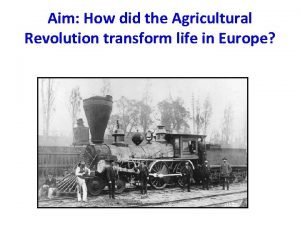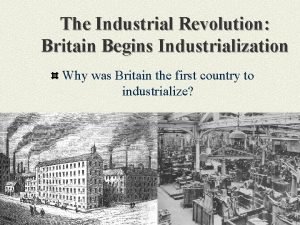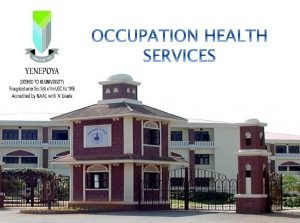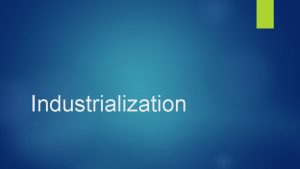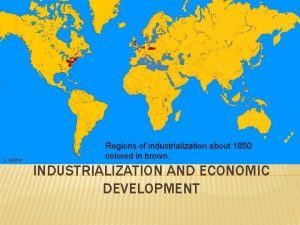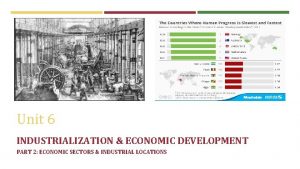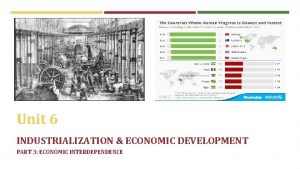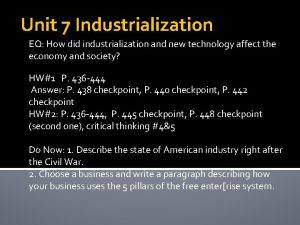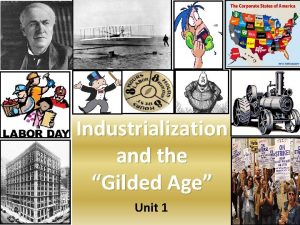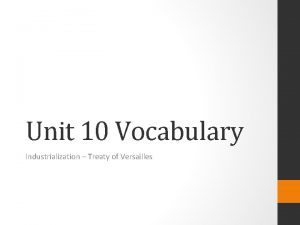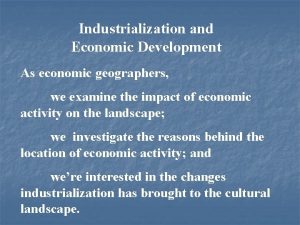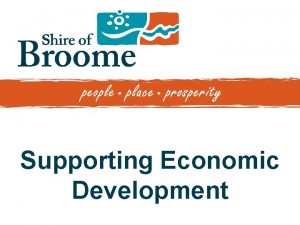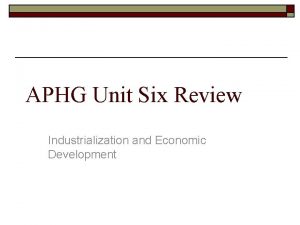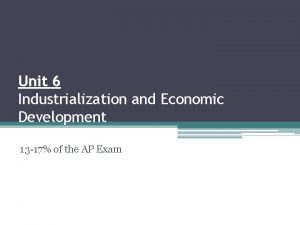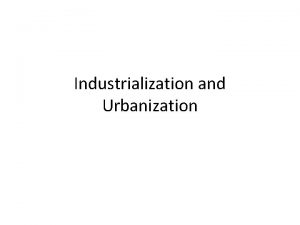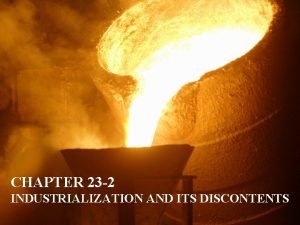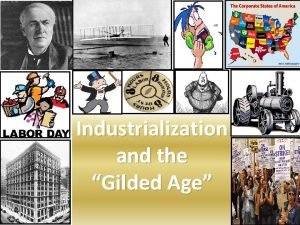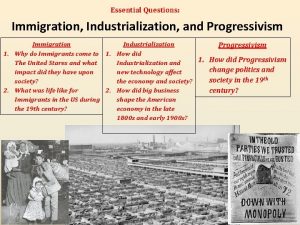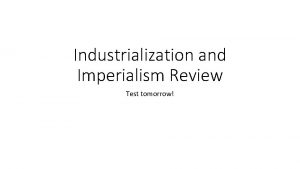Industrialization and Economic Development Unit VI Intro Economic
















































- Slides: 48

Industrialization and Economic Development Unit VI

Intro • Economic geographers study the locations and reasons for economic patterns in the world’s human landscape • Fast Fact – Almost half of the people in the world live on the equivalent of less than $2 a day, and about 20% live on less than $1 a day – People in the 20 richest countries on average earn 37 times more than people in the 20 poorest countries

Economic Classifications • ECONOMY – The system of production, consumption, and distribution • • PRIMARY SECTOR SECONDARY SECTOR TERTIARY SECTOR QUATERNARY SECTOR – Assemble, and process information – Ex. University research and investment analysis • QUINARY SECTOR – Highest levels of decision making – Ex. Legislature or presidential cabinet

Industrialization • The growth of manufacturing activity in the economy or a region • Usually occurs alongside a decrease in the number of primary economic activities • Fast fact – The amount of world trade since 1950 has increased 20 fold, from $320 billion to $6. 8 trillion – This increase in the trade of manufactured goods is three time larger than the increase in the rate of the production of those goods

The Industrial Revolution • Began in England in the 1760 s • Later diffuses to other parts of western Europe • During this period… machines replaced human labor and new energy sources emerged (Coal) • At beginning it was textile focused industry

Cont… • England’s Industrial Revolution defined by the rise of assembly line manufacturing • Industries powered by coal so they clustered around coal fields • Led to development of a clear industrial landscape and working class housing area • Along with industrial growth… transportation infrastructure grew to allow improved shipping supplies to urban factories

Cont… • Farming also mechanized • COMMODIFICATION – Factory owners looking at their human labor as commodities (objects for trade) with price tags per hour – As opposed to seeing them as people

In the beginning… • Factory like labor first started in households • Growth of factories initially by water sources which supplied the energy • Then factories grew near coal and could move farther away from water • Away from water, factories could build out rather than up • By the 1960 s, oil replaced coal – US, Russia, Venezuela were big oil suppliers prior to the 60 s – Middle east emerged in the 60 s

Diffusion of Industrialization • By 1825 the technology had diffused to N. America and Western Europe • Thrived in places with coal deposits – Ex. Ohio and Pennsylvannia • By the 1920 s production breaks down into differentiated processes – FORD PRODUCTION METHOD (FORDIST) • Build out rather than up • Only one floor so the product could by transported throughout the assembly line without problems

WEBER’S LEAST COST THEORY • ALFRED WEBER • Predicted where industries would locate based on the places that would be the lowest cost to them

Assumptions of Weber’s model • Assumes the cost of transportation is determined by the weight of goods being shipped and the distance to the market • The heavier the good and/or the longer the distance, the more expensive it is to ship • Assumes industries try to minimize costs • Assumes markets are in fixed locations • Assumes labor is in fixed locations • Like Von Thunen… assumed soil and political/cultural landscape is uniform

Four factors of model • Industry location driven by – Transportation – Labor – Agglomeration – Deglomeration

Transportation and Distance • Must consider weight and distance • Not just distance to market… but from raw materials or energy sources to the industry • During Industrial revolution, factories locate near coal (energy), after invention of electricity they were no longer tied down to the energy source • Also had to locate near raw materials

Cont… • SPATIALLY VARIABLE COSTS – Costs that varied or changed based on location – Ex. Using heavy raw materials you might build closer to the raw material • WEIGHT LOSING PROCESSES – Ex. Paper production – MATERIAL ORIENTATION

Cont… • WEIGHT GAINING PROCESSES – Locates near market – Ex. Soda Industry – MARKET ORIENTATION

Cont… • SPATIALLY FIXED COSTS – Some industries maintain the same costs no matter where they are – Usually light products with high value – Ex. Computer chips – May be called FOOTLOOSE INDUSTRIES

Labor Costs • Not only human costs but machinery and money to purchase tools • SUBSTITUTION PRINCIPLE – When an industry substitutes labor costs for transportation costs – Labor costs decrease… Transportation costs increase… in the long run they will save

Agglomeration • Industries that clump together for mutual advantage • Can share costs • AGGLOMERATION ECONOMICS – Saving money for both industries and consumers • HIGH TECH CORRIDOR • TECHNOPOLE • BACKWASH EFFECT – When other regions suffer a drain of resources and talent • LOCATIONAL INTERDEPENDENCE – Industries choose locations based on where the competitors are located – Ex. Off highway exits… Gas stations AGGLOMERATE based on LOCATIONAL INTERDEPENDENCE • Allows them to share the market

Deglomeration • When an agglomeration becomes too clustered/too crowded in negatively affect the industry so they split up for more space • “unclumping” of industry

Criticisms of Weber’s Model • Does not identify the fact that markets and labor are often mobile • Labor force varies by – Skill – Age – Gender – Language – Etc… • Some transportation costs are not necessarily proportional to distance

Contemporary Patterns and Impacts of Industrialization and Development

Development • Process of improving the material condition of people through the growth and diffusion of technology and knowledge • MDCs vs. LDCs – On an economic spectrum… • Not just wealth…may have additional social, economic, demographic factors involved

UN Human Development Index • HDI • Used to compare various development regions • Three factors – Life expectancy – Average educational levels – Standard of Living – – On a score from 0 -1 Norway tops at. 965 US around 8 th place – 0. 91 Democratic Republic of the Congo in last at. 286


Economic component of HDI • Gross Domestic Product (GDP) – The value of total outputs of goods and services produced in a country usually over 1 year – Per capita = person – In US… GDP per capita is around 35, 000 or $10 -15 an hour vs. $0. 50 in LDCs

PPP • Purchasing Power Parity • Calculating the exchange rates required for each currency to buy an equal amount of goods • BIG MAC INDEX • “Apples to Apples”

In comparison • IN US… rich about 15 times more wealthy • IN Guatemala… rich about 75 times more wealthy that the poorest 10%

Informal Sector • • Data not reported They are “off the books” Not included in GDP May limit the usefulness of GDP

Development Gap • The widening gap between MDCs and LDCs • GDP tripled in MDCs within the last decade • GDP only double in LDCs within the last decade • Rate of Natural Increase (RNI) dropped 85% in MDCs in the last decade… only 5% in LDCs • NORTH – SOUTH GAP – Northern Hemisphere is more developed

Structuralist Reasons for the Development Gap • Argue LDCs are locked into a vicious cycle of entrenched underdevelopment by the global economic system • DEPENDENCY THEORY – Says political and economic relations among countries limit the ability of LDCs to modernize and develop – Countries are INTERDEPENDENT – IMMANUEL WALLERSTEIN’S THEORY • WORLD SYSTEMS ANALYSIS – – CORE, PERIPHERY, SEMIPERIPHERY Core depends on the Periphery If there is a core there is a periphery The core exploits the periphery – Ex. Europe and Africa

Liberal theories of Development: ROSTOW’S MODERNIZATION MODEL • LIBERAL THEORIES – Says all countries can develop • MODERNIZATION MODEL – “ladder of development”


Criticisms of Rostow’s Model • Based on Anglo American and Western European Development • Does not account for “roadblocks” to development like neocolonalism • Considers each country independent rather than interdependent

Reducing the Development Gap: The self-sufficiency approach • The ability to provide for its own people, independent from foreign economies • Investments should be spread over the entire economy • Ex. China, India, E. Europe, Africa all tried it… didn’t work – Corruption and inefficiency limited gains – India never improved products – Governments paid failing businesses to stay open

Reducing the Development Gap: International Trade • Pushes a country to identify its unique set of strengths in the world and to channel investment toward building on those strengths • COMPARATIVE ADVANTAGE • Japan and High tech products

Globalization • The increasing sense of interconnectedness and spatial interaction among governments, cultures, and economies • Originally just used to describe economics… now it is more broad • Ex. Spread of MTV • May lead to resentment • Disneyification… Mc. Donoadlization

Multinational Corporations • MNCs • Or Transnational Corps… TNCs • Headquarters in one country and production facilities in others • CONGLOMERATE – One massive company that owns and operates smaller companies – Ex. A soda company also owns the bottling company and food coloring company

Outsourcing • Practice of an MNC to relocate a piece or all of its manufacturing in other countries

Newly Industrialized Countries • NICs • Asian Tigers – Taiwan, S. Korea, Hong Kong, Singapore – Make up the Pacific Rim economic region

Foreign Direct Investment • Investment in LDCs • SPECIAL ECONOMIC ZONES • EXPORT PROCESSING ZONES – FREE TRADE ZONES

Maquiladoras • Special economic zones in Mexico along the US border • Part of NAFTA • Used to create jobs

New International Division of Labor • Breaks up manufacturing process among many countries

Free trade vs. Fair Trade

Structural Adjustment and Privatization • Structural Adjustment – Stipulations that require the country receiving a loan to make economic changes in order to use the loan • Privatization – The selling of publicly operated industries to market driven corporations

Non governmental organizations • To assist in boosting economic development and human rights throughout the world’s peripheral regions • NGOs supply resources and money

Globalization and the Environment • Resources are being depleted • Travel has increased – ECOTOURISM – Costa Rica has turned a huge percentage of its land into protected areas that can be used for ecotourism – “Jungle Swing” • Only damage to environment is the guidewires

Cont… • Sustainable development – A rate of growth and resource-consumption that can be maintained from one generation to another – UN called for conservation and careful use of resources • • Avoid overfishing Care for the soil Preserve forests Protect species from extinction Reduce air pollution Recycle Use alternative fuels

Greenhouse effect • Caused by CFC, CO 2, Methane • Causes world temp to rise • Kinda like what happens in a car on a hot day • Related to OZONE LAYER DEPLETION – Global Warming – May cause sea levels to rise
 Conclusion of growth and development
Conclusion of growth and development Economic growth vs economic development
Economic growth vs economic development How would bivariate data best be displayed?
How would bivariate data best be displayed? Us government unit 1 study guide
Us government unit 1 study guide Industrialization and nationalism
Industrialization and nationalism Chapter 10 lesson 1 the industrial revolution
Chapter 10 lesson 1 the industrial revolution -have strength to match the growth of industrialization
-have strength to match the growth of industrialization Chapter 10 lesson 1 the industrial revolution
Chapter 10 lesson 1 the industrial revolution Under imperialism the stronger nation attempts to
Under imperialism the stronger nation attempts to Social darwinism industrial revolution
Social darwinism industrial revolution Unit 10, unit 10 review tests, unit 10 general test
Unit 10, unit 10 review tests, unit 10 general test Human capital education and health in economic development
Human capital education and health in economic development Economic growth and development
Economic growth and development Swodf
Swodf African institute for economic development and planning
African institute for economic development and planning Import substitution industrialization
Import substitution industrialization Industrialization causes
Industrialization causes Russian revolution of 1905 definition ap world history
Russian revolution of 1905 definition ap world history Industrialization aphg definition
Industrialization aphg definition Industrialization spreads chapter 25 section 3
Industrialization spreads chapter 25 section 3 Chapter 9 section 3 industrialization spreads
Chapter 9 section 3 industrialization spreads Chapter 9 section 3 industrialization spreads answer key
Chapter 9 section 3 industrialization spreads answer key Footloose industries example
Footloose industries example Industrialization 1865 to 1901
Industrialization 1865 to 1901 Result of industrialization
Result of industrialization American laws
American laws The beginnings of industrialization chapter 9 section 1
The beginnings of industrialization chapter 9 section 1 Manchester2
Manchester2 The beginnings of industrialization
The beginnings of industrialization The beginning of industrialization chapter 9 section 1
The beginning of industrialization chapter 9 section 1 Beinnings
Beinnings Chapter 17 revolutions of industrialization
Chapter 17 revolutions of industrialization Industrialization crash course
Industrialization crash course William cooper industrial revolution
William cooper industrial revolution Lesson 5 - industrialization
Lesson 5 - industrialization Whats the definition of industrialization
Whats the definition of industrialization Industrialization
Industrialization Big business lesson 3
Big business lesson 3 Which resources played crucial roles in industrialization?
Which resources played crucial roles in industrialization? Consequences of industrialization
Consequences of industrialization Pools industrialization definition
Pools industrialization definition Industrialization
Industrialization Industrialization
Industrialization Albanla
Albanla Industrialization
Industrialization Industrialization
Industrialization Industrialization definition
Industrialization definition What is industrialization
What is industrialization Health problems due to industrialization ppt
Health problems due to industrialization ppt




